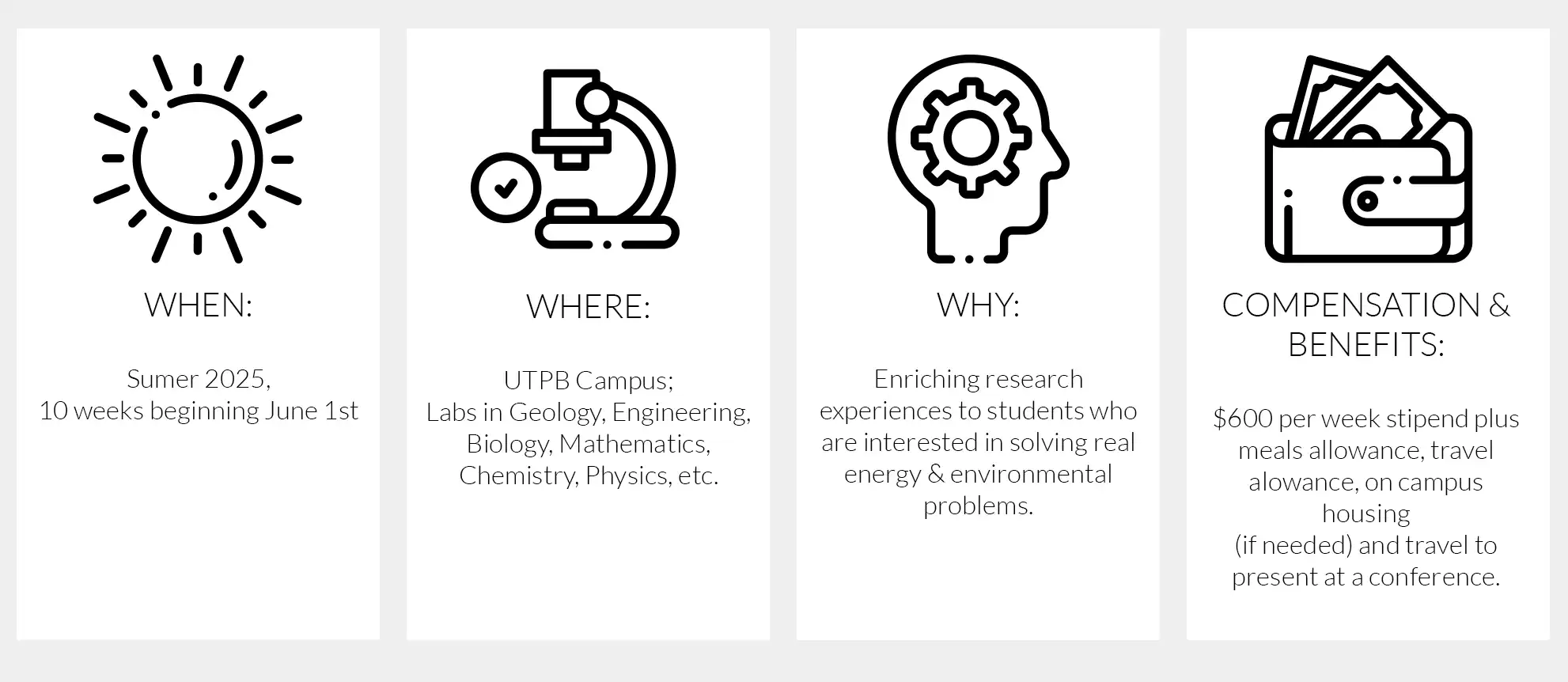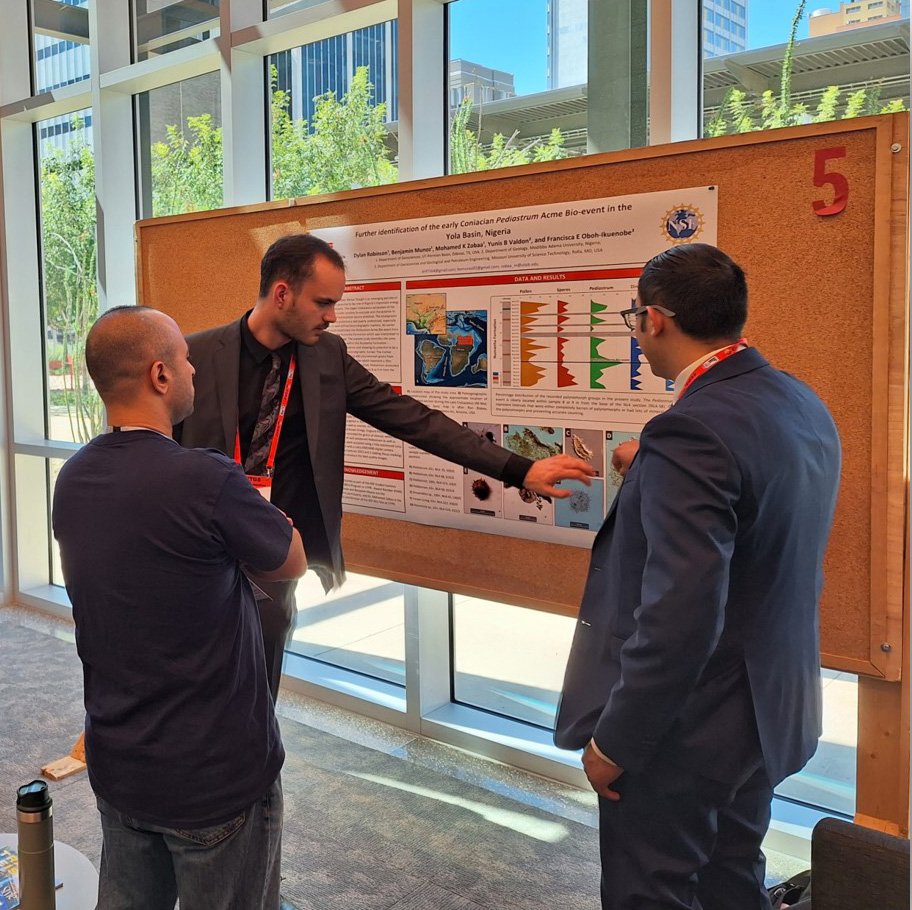RESEARCH STUDENTS
 Trinity White
Trinity White
Project Title: Anthropogenic Effect on Lake Eerie Revealed through Pollen Analysis
Statement: For the REU project my team worked with sediment from Lake Eerie. It is the most biologically active of the Great Lakes and thus is a great target for Palynological Study. Anthropogenic effects on the lake have long been speculated to be negative, specifically on plants and animals. In previous studies sediment particle size, pollution, and various other factors have been considered to evaluate the impact of human activity in the lake. However, studies examining direct abundances of pollen are few. But they could give insight to trends caused by human interference. Our team prepped the slides using palynological methods and examined Core ER36. The analysis identified several trends that show diversity in certain species decreasing in time and even extinction patterns. The pollen taxa of interest are Cupressus, Pinus, Chenopoda, Quercus, Ambrosia, Juglans, Carya and Tillia. Other pollen and spores were also counted when slides were very low in abundance. Five significant trends emerged. Five major trends were identified: 1) Palynomorph abundance is highest in the oldest core samples and declines toward the surface. 2) Quercus (oak) and Pinus (pine) are the most dominant taxa throughout, with oak increasing at the expense of pine over time. 3) Cupressus (cypress) and Chenopods (goosefoot) show fluctuating abundance but no significant long-term trend. 4) Ambrosia (ragweed) peaks in the lower and middle sections of the core, with minimal presence near the top. 5) Juglans (walnut) varies in abundance, reaching its highest levels near the surface and lowest in deeper layers. Additionally, two microplankton species were observed to peak at a depth of 18–19 cm and disappear by 6–7 cm. Microplastics first appear at 9–10 cm and become most abundant in the uppermost layers, highlighting recent anthropogenic contamination.

Rose Bezenhafer
Project Title: Tracing Human Impact on Lake Erie's Sediments Through Pollen Records
For this study, our team examined the ecological impact of anthropogenic activity on Lake Erie by analyzing pollen grains and microfossils that have been preserved in a sediment core sample. A total of 41 samples had to be processed in order to be examined. By using Hydrochloric acid (HCl) to remove carbonates and Hydrofluoric acid (HF) to remove silicates only the organic are left over to be examined under a microscope. Each sample was then mounted on a microscope slide and thoroughly examined by each team member to identify and document the preserved palynomorphs and microfossils. This process provided both observational and statistical data on the ecological changes and anthropogenic influence on the lake and surrounding environment.
 Alicia Polvon
Alicia Polvon
Project Title: Evaluation of [Bmim][Tf₂N] for Produced Water Treatment
The Permian Basin produces an estimated 20 million barrels of produced water each day, creating significant challenges for disposal and treatment. Produced water typically contains high salinity and variable chemical compositions, making many traditional treatment options economically unviable for meeting safe surface disposal requirements from the EPA. Ionic liquids are a potential stable solution for produced water challenges because their structure can be customized to improve performance for specific water compositions.
In this project, the ionic liquid 1-butyl-3-methylimidazolium bis(trifluoromethylsulfonyl)imide ([Bmim][Tf₂N]) was synthesized from 1-butyl-3-methylimidazolium bromide and lithium bis(trifluoromethylsulfonyl)imide and tested with actual produced water samples for desalination efficiency across varying compositions. The evaluation focused on measuring changes in pH, salinity, and organic content to determine the potential of [Bmim][Tf₂N] for effective produced water treatment in the Permian Basin.
 Salma Zobaa
Salma Zobaa
Project Title: Optimizing Hydraulic fracturing Parameters of Horizontal Wells in Northern Midland Basin, Texas, USA
This research project focused on analyzing oil well data to better understand the relationship between hydraulic fracturing parameters and oil production. The work involved collecting and standardizing data from fifty active oil producing wells, with particular attention to variables like fracturing water volume, proppant usage, number of fracturing stages, length of horizontal well, and barrels of oil produced. Using R, multiple linear regression models were developed to evaluate which parameters had the greatest influence on output. Correlation tests were also performed to better grasp the relationship between dependent and independent variables. The purpose of the project was to identify data-driven strategies that could support more cost-effective oil production in the U.S., due to higher operational costs compared to other oil-producing regions. The findings are then compiled into a formal research paper, supported by statistical analysis and visualizations.
 Emily Benzenhafer
Emily Benzenhafer
Project Title: Developing a Standardized Well Database for 3D Geomodeling of the Midland Basin
The one-page summary: This research was centered on developing the critical data infrastructure for a basin-scale 3D geomodel of the Midland Basin, a major petroleum province. The project involved a detailed investigation of the regional geology to establish a consistent stratigraphic framework. A primary task was to standardize the formation list for the basin, ensuring all well data could be correlated accurately. This was followed by the careful digitization of vintage well logs and formation top information, transforming raw data into a usable format for Petrel geomodeling software. By performing these crucial data management and quality control steps, this project provided essential assistance for the development of the final 3D model, which will be used for advanced seismic interpretation and geomechanical analysis.
 Dominick Brown
Dominick Brown
Project Title: Robotic Arm Design and Simulation Using MATLAB and Simscape
I designed and simulated a robotic arm using MATLAB’s Robotics System Toolbox and Simscape Multibody. The project involved importing a CAD model, applying forward and inverse kinematics, and testing position and torque-based control methods. Simulations demonstrated precise movement and showcased how MATLAB can integrate design, control, and visualization into a single workflow.
 Natalya Alvarez
Natalya Alvarez
Project Title: Quantifying Functional Factors on Performance of Multi-stage Hydraulically Fractured Horizontal Wells in Northern/Southern Midland Basin
Through data collection and the review of similar analysis in other basins, we’ve studied the factors which may be used to optimize the profit of oil extraction using multistaged hydraulically fractured horizontal wells. We focused on the three counties: Regan, Martin, and Andrews, all in west Texas. Information was searched from the website of University Lands, a public database. This research is important to the companies to extract the same amount of energy (oil and gas) at the minimum cost. By discovering which factors lead to the most monetary profit, we can learn the best routes for extracting oil to create a greater payback. Multistage hydraulic fracturing in horizontal wells is specified in our research as it enables oil and natural gas production from the shale and other tight formations- our project specializing in Wolfcamp Shale Formation due to our location in the Permian Basin-, which is lucrative in the production of tight oil and natural gas. Our research has shown that there are many parameters which contribute to the monetary gain of oil production companies. Our overall goal is to quantify contributions of these factors, and seek out the least profitable factor which, when reduced, we predict will create an overall greater profit in the overall performance for future wells.
 Shijay Sivakumar
Shijay Sivakumar
Project Title: Validating the Specificity of Novel Primers for a Biofilm Study
The goal of my project was to determine if three sets of primers designed by students from last year’s REU cohort would amplify genes in Pseudomonas. If so, these primers will be used to amplify segments of target genes as positive controls for quorum sensing and biofilm development in closely related bacterial strains obtained from fluids flushed from ballast tanks.
First, I learned how to make nutrient agar and broth to grow the bacteria. I streaked a stock culture of Pseudomonas onto agar plates using aseptic technique to obtain individual colonies, I then grew up one colony overnight in broth in preparation for DNA extraction. After isolating the DNA from the cells, I used Qubit fluorometry to check the DNA concentration and adjust it so that it would work for polymerase chain reactions (PCR). Next, I set up a PCR reaction using universal primers to make sure the DNA was amplifiable and free of inhibitors. Finally, I set up three separate PCR reactions with the three novel primer sets targeting the algU, lasR, and clpP genes. These three genes were found to be present in the genomes of several of the isolated strains and are important for biofilm formation: algU helps control alginate production, lasR is a key regulator for quorum sensing, and clpP helps the cell deal with stress. After running the PCR products on an agarose gel, I saw clear bands at the expected sizes for all three genes. This means the primers work and are specific for their gene targets.
 Cristian Garcia
Cristian Garcia
Project Title: Building the Geologic Framework for a 3D Model of the Central Basin Platform
This project focused on building the foundational dataset required for a comprehensive 3D geomodel of the Central Basin Platform, a complex and economically significant region of the Permian Basin. The research began with an in-depth study of the regional geology to understand its unique stratigraphic architecture. A key contribution was the creation of a standardized master formation list to resolve inconsistencies across varied data sources. A significant portion of the project involved meticulously digitizing vintage well log data and formation top information from numerous wells, creating a clean, quality-controlled dataset ready for Petrel modeling software. This essential data preparation works directly assisted in the
construction of the 3D geomodel, which is designed to enhance the characterization of reservoir quality and support regional subsurface analysis.








 Dylan Robinson
Dylan Robinson Benjamin Munoz
Benjamin Munoz Sami Ahmed
Sami Ahmed





 RosAaliyah Olguin
RosAaliyah Olguin Trinity White
Trinity White
 Alicia Polvon
Alicia Polvon Salma Zobaa
Salma Zobaa Emily Benzenhafer
Emily Benzenhafer Dominick Brown
Dominick Brown Natalya Alvarez
Natalya Alvarez Shijay Sivakumar
Shijay Sivakumar Cristian Garcia
Cristian Garcia